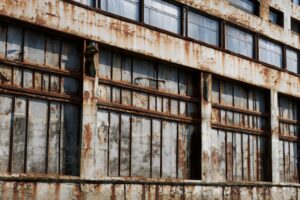A condemned building frequently raises worries among property owners, residents, and the nearby community. The word “condemned” might suggest a sense of finality, yet it also signifies the start of a journey. From the condemnation declaration to its eventual resolution, this process affects not just the property itself but also the surrounding people and community.
This blog seeks to clarify what it entails for a building to be condemned, the reasons it may occur, and what actions follow. If you’re a property owner, worried neighbor, or just interested in the effects, this guide will provide all the information you need.

The Condemnation Process
What Does Condemnation Mean?
Condemnation is an official announcement by local authorities that a structure is hazardous or unsuitable for occupancy. It is motivated by major worries regarding public safety, structural integrity, or health hazards. The choice to condemn a property is made with great care and aims to protect individuals from risks posed by possibly hazardous structures.
Why Are Buildings Condemned?
Various elements may result in a building being deemed uninhabitable, including these categories:
- Structural Issues
Significant decline like falling roofs, deteriorating walls, or weakened foundations can make a building too unsafe to inhabit.
- Health Hazards
Mold infestations, asbestos contamination, lead exposure, or severe pest presence are common reasons behind condemnation.
- Code or Zoning Violations
Disregarding building regulations, conducting unauthorized alterations, or utilizing the property contrary to zoning ordinances can lead to condemnation.
- Neglect or Abandonment
Abandoned structures neglected often turn hazardous due to insufficient upkeep or vandalism, leading officials to deem them uninhabitable.
Who Declares a Building Condemned?
Building inspectors, housing agencies, or code enforcement offices usually declare a building condemned. Regular inspections, public complaints, or visible signs of decline like drooping walls or bare wiring often trigger the procedure. Once officials declare the condemnation, they enforce it legally and initiate the resolution process.
Immediate Consequences of Condemnation
Condemnation isn’t merely a tag for a structure; it involves prompt measures aimed at ensuring the safety of the public and those living in the building.
Evacuation Orders
When a structure is condemned, tenants must vacate the premises immediately. Evacuations could happen within hours if the building presents an urgent danger, including risks of falling, fire, or contact with hazardous materials.
Utility Shutoffs
In condemned buildings, electricity, gas, and water are typically shut off to avert potential dangers like fires, gas leaks, or flooding, making the surroundings as secure as possible.
Posting of Notices
Marked signage indicates condemned properties to alert the public and prevent unauthorized entry. These announcements frequently contain information regarding the condemnation and legal limitations.
Responsibilities of the Property Owner
When a building is deemed unsafe, the owner takes on significant legal and financial obligations.
Legal Obligations
Local authorities require property owners to follow their directives, which include securing the premises, completing essential repairs, or demolishing the building if restoration proves impossible. Failure to comply may result in penalties, fines, or even loss of ownership.
Financial Implications
Condemnation comes with significant financial costs, such as:
- Repair Costs
Extensive repairs may be required to bring the building back up to code.
- Demolition Costs
When repairs aren’t viable, costs for demolition, debris disposal, and site readiness can be significant.
- Revenue Loss
Rental properties lose their income potential during condemnation, further straining the owner’s finances.
Appealing the Condemnation
Property owners might have the ability to contest a condemnation if they feel it is unwarranted. This usually entails submitting independent inspection reports or expert assessments to contest the decision.
Options for the Condemned Building
A building’s condemnation isn’t necessarily the end of the road. Property owners may choose one of these options to address the situation:
Repair and Restoration
If the property possesses considerable worth, addressing code infractions and bringing it back to a secure, livable condition can be a beneficial investment. Restoration frequently requires significant structural repairs and adherence to current safety regulations.
Demolition
When repair costs are too high or the structure is irreparable, tearing it down is the most effective solution. Removing the existing structures allows for new construction or different purposes for the property.
Sale of the Property
Owners unable to handle repair or demolition expenses have the alternative of selling the condemned building. Investors and developers frequently purchase these properties to transform them into lucrative projects.
Impact on the Community
Condemned properties can lower property values nearby, discourage investment, and reduce the tax income produced in the region.
Safety Concerns
Unaddressed condemned buildings can become dangerous, attracting criminal activity or accidents from trespassers. Proper management ensures that these safety risks are minimized.
Economic Effects
Condemned properties can decrease neighboring property values, deter investment, and diminish the tax revenue generated in the area.
Urban Renewal Opportunities
On the brighter side, condemned properties present opportunities for urban renewal. Many communities have leveraged condemned sites to create affordable housing, commercial spaces, or public facilities, contributing to neighborhood revitalization.
Turning Condemnation Into Opportunity
When a structure is condemned, it clearly signals the necessity for a prompt response and immediate intervention. Consequently, by proactively managing these condemned properties, owners can not only reduce risks but also ensure they meet legal requirements. Furthermore, they may uncover significant potential for revitalization and redevelopment.
Communities also have a vital role to play, transforming condemned spaces into assets that enhance public safety, economic growth, and livability. Collaboration between property owners, local authorities, and residents is essential to achieving these goals.
Every condemned property has a way forward, whether through restoration, demolition, or selling a fire-damaged house. Through assertive and forward-thinking actions, we can transform obstacles into opportunities that advantage all parties concerned.
Previous